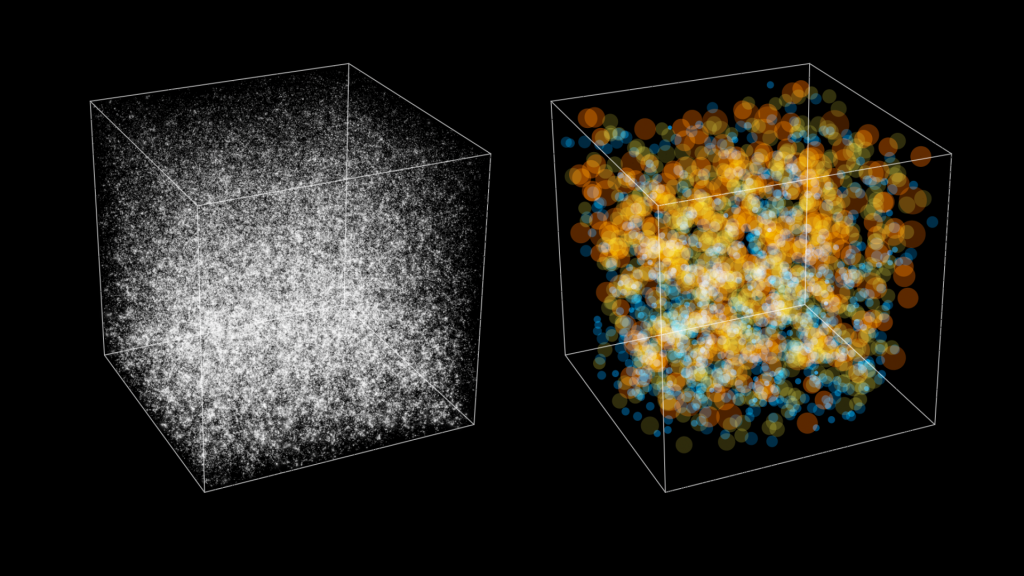1 min read
Hickson Compact Group 87: A Minuet of Four Galaxies

This troupe of four galaxies, known as Hickson Compact Group 87 (HCG 87), is performing an intricate dance orchestrated by the mutual gravitational forces acting between them. The dance is a slow, graceful minuet, occurring over a time span of hundreds of millions of years.
The Wide Field and Planetary Camera 2 on NASA's Hubble Space Telescope (HST) provides a striking improvement in resolution over previous ground-based imaging. In particular, this image reveals complex details in the dust lanes of the group's largest galaxy member (HCG 87a), which is actually disk-shaped, but tilted so that we see it nearly edge-on. Both 87a and its elliptically shaped nearest neighbor (87b) have active galactic nuclei which are believed to harbor black holes that are consuming gas. A third group member, the nearby spiral galaxy 87c, may be undergoing a burst of active star formation. Gas flows within galaxies can be intensified by the gravitational tidal forces between interacting galaxies. So interactions can provide fresh fuel for both active nuclei and starburst phenomena. These three galaxies are so close to each other that gravitational forces disrupt their structure and alter their evolution.
From the analysis of its spectra, the small spiral near the center of the group could either be a fourth member or perhaps an unrelated background object.
The HST image was made by combining images taken in four different color filters in order to create a three-color picture. Regions of active star formation are blue (hot stars) and also pinkish if hot hydrogen gas is present. The complex dark bands across the large edge-on disk galaxy are due to interstellar dust silhouetted against the galaxy's background starlight. A faint tidal bridge of stars can be seen between the edge-on and elliptical galaxies.
HCG 87 was selected for Hubble imaging by members of the public who visited the Hubble Heritage website (http://heritage.stsci.edu) during the month of May and registered their votes. The HST exposures of the winning target were then acquired in July 1999 by the Hubble Heritage Team and guest astronomers Sally Hunsberger (Lowell Observatory, Flagstaff, Arizona) and Jane Charlton (Pennsylvania State University).
About the Object
- R.A. PositionR.A. PositionRight ascension – analogous to longitude – is one component of an object's position.20h 48m 10.99s
- Dec. PositionDec. PositionDeclination – analogous to latitude – is one component of an object's position.-11° 50' 24.0"
- ConstellationConstellationOne of 88 recognized regions of the celestial sphere in which the object appears.Capricornus
- DistanceDistanceThe physical distance from Earth to the astronomical object. Distances within our solar system are usually measured in Astronomical Units (AU). Distances between stars are usually measured in light-years. Interstellar distances can also be measured in parsecs.120 Mpc (roughly 400 million light-years)
- DimensionsDimensionsThe physical size of the object or the apparent angle it subtends on the sky.The galaxy group has a diameter of 52 kpc (170,000 light-years).
About the Data
- Data DescriptionData DescriptionProposal: A description of the observations, their scientific justification, and the links to the data available in the science archive.
Science Team: The astronomers who planned the observations and analyzed the data. "PI" refers to the Principal Investigator.Principal Astronomers: J. Charlton (PSU), S. Hunsberger (Lowell Obs.), F. Hamilton, H. Bond, C. Christian, J. English, L. Frattare, A. Kinney, Z. Levay, K. Noll (The Hubble Heritage Team (STScI/AURA) - InstrumentInstrumentThe science instrument used to produce the data.HST>WFPC2
- Exposure DatesExposure DatesThe date(s) that the telescope made its observations and the total exposure time.July 19-25, 1999, Exposure Time: 6.6 hours
- FiltersFiltersThe camera filters that were used in the science observations.F450 (B), F555W (V), F675W (R), and F814W (I)
- Object NameObject NameA name or catalog number that astronomers use to identify an astronomical object.Hickson Compact Group 87, HCG 87
- Object DescriptionObject DescriptionThe type of astronomical object.Cluster of Interacting Galaxies
- Release DateSeptember 2, 1999
- Science ReleaseA Minuet of Galaxies
- Credit
Share
Details
Claire Andreoli
NASA’s Goddard Space Flight Center
Greenbelt, Maryland
claire.andreoli@nasa.gov





























